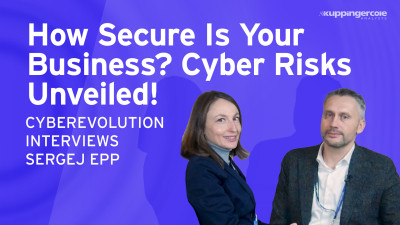Hi, good afternoon everyone. Thank you for my name is, I'm with Empower, the software architect. It's a pleasure to join this event to discuss and frontier in cybersecurity and space. There is behavioral biometrics and ai. So today I'm gonna share some insights into these technologies are not just enhancing, but basically transforming our approach to identity verification and security. So let's kick off the session.
Alright, so you might be wondering what Leonard order cap has to do with this topic. Well, many technically this pitch from the movie You Can, which is based on a true story set in the 1960s. In that movie, Leonardo plays the role of Frank Abbeel Jr. A teenager who impersonated professional professor and doctor and many other, and he pulled off some of the most incredible cons of that era. He launched into a series of impersonations that led him to 26 countries.
He was able to cash forged checks worth over millions of dollars and while keeping the law enforcement on the dose.
So what was Frank's secret? So basically it all comes down to understanding people and trust and how that trust can be manipulated. So Frank didn't just wear the uniform and he actually played the role so well, confidence and John and his ex were so convincing that the people just believed him and he also managed to dodge law enforcement for years.
So he was good at spotting people where they were not careful enough and where they didn't double check who he really was and that's how he slipped how to talk to people and how to ask the right questions and get the information he needed without ever rating suspicion. But eventually the law took his course and he couldn't do the law forever.
So, so is this story important?
So the point of sharing this story is to highlight a crucial lesson that in our digital world we have lots of francs who don't need to wear physical disguise. Instead the social engineering and phishing techniques to create digital disguises to ate trustworthy entities.
Such banks, companies and just like Frank, they're good at finding the gaps where people forget to verify who they're really dealing with and with their rise of generative AI and defects, it's getting insanely easy to fool people like cyber criminal now create fake digital entity in media like images, audio, video that looks so incredible and this makes it even harder to tell what's genuine and what's not and especially for those people who are not so tech savvy. So this brings us to a key pain point.
Like so despite the impressive tech we have so far like firewalls, we have twin software encryption, we have access manage rich base authentication and the list goes on. But all of these technologies do not cover the weakest link in the chain, which is human vulnerability. So no matter how high tech our securities, it can completely cover for human mistakes. Phishing for instance, doesn't smash through digital through our through the cracks by on our to trust people. And it's in the simplest trick that managed to sneak past aiming our fanciest securities setup.
So let's look at how serious the impact is. Alarming statistics, every day 3.4 billion malicious emails are sent out. It's like every single person on the planet getting half an email every day and all of them are up to no good. And in every 20 seconds a new phishing site pops up time. We finish this slide, several modes will have launched and the third one is that real jaw dropper. So 90% of corporate security breaches begin with a phishing attack, which means almost every time you hear me getting hacked, there's a good chance it started with someone clicking on a bad link, right?
So and since 2020 80% of organizations have seen increase in phishing attacks, there's almost nearly everyone.
So this is one of the issue, biggest issue that we face, which is the human element and it not prevent an authorized user from being manipulated.
So, and cyber criminals know this and they use it to their advantage. They don't always to our technical defenses, they manipulate all so that they compromise their own security. This could involve checking someone into clicking a malicious link that bypasses MFA through phishing attacks that intercept verification code in real time. So problem that was the best way to avoid the attacks.
Okay, so according to the simple, just never check your emails problem solve, right?
So obviously this is not a practical solution, but it does highlight a real challenge. We face that despite all the trainings and efforts to raise cybersecurity awareness that still exist and we need smarter, more effective strategies to truly protect, protect metrics. And continuous application comes in, and this might be complex but it's all about analyzing patterns to naturally interact with our devices. So this is just about, this is not just about what you do but how you do it.
And the way and the way it works basically is just collect various data points. For instance, we have keystroke dynamics and this monitors how you type looks at your typing speed, the rhythm, and even the pressure you apply to touch devices. So if you think about it, no two people can type exactly the same way, right? Some of us type fast pounding the keys if you're a programmer, while others might type more slowly.
And so, and some people just make, make more use of the certain keys like the shift key for capital letters while other might use cap lock. So all of these tiny small details basically creates a unique typing pattern that can be used to verify your identity.
Then we have mouse movements. So this tracks the way how you move and how you click your mouse since everyone has a unique way of navigating their screen.
So, so this can also be used as a key identifier. Then there's gait analysis. This was interesting. It basically analyzes your walking patterns and it captures step patterns using video images and then convert this data into a mathematical equation. Pretty much similar to what Apple does with this face id. So for instance, it can look at your, the length of your stride, the rhythm of your steps and how your body moves as you walk.
It's ads unique as fingerprint and it can be used to verify your, and this already being used, various real world applications such as security and surveillance systems in airports and heights, security to based on their walk. Then lastly we have interac patterns and this observes how you interact with your application overall and it includes your navigation habits, the way you scroll, and even at the angle at which you hold your device. So by continuously monitoring these behaviors, we can create a unique profile for each user.
So if someone else tries to use your device, their behaviors will be detected and the actions to protect your data. So if this way, if someone gets past your initial, they won't be able to make the way you interact with your device, right? So this approach helps us to basically stay ahead of cyber S by focusing on what makes each of us unique in our digital interactions.
And it means we can use human behavior as key part of our security strategy. And traditional security measure as we discussed, have the limitation and that's where the behavioral biometrics comes in.
And because it analyzes user behavior patterns in real time, for instance, if someone behavior suddenly changes, maybe tapping style or mouse movement, the system can raise a red flag. So it's not just about checking who you are when you log in, it's about continuously watching that someone else might be using your account. And what's great about this approach is it doesn't rely on a single one-time check. Instead it monitors the behavioral patterns throughout the entire user session.
So which means the system can, so the system is constantly on the lookout for any signs of trouble, not just at the login.
So let's see how this continuous authentication works using the power of ai. So the process start by collecting thousands of data points every time you interact with your device an application and it looks at how you type move your mouse and navigate through applications. And each action you take is recorded and then analyzed and it helps creating a detailed profile, your unique behavior and you use your device.
The system continuously updates its profile so it's not just a one-time check and it's an on ongoing process. The system is always watching and learning, making sure that it's really you using the device. And obviously AI plays a crucial on this in this as it's uses machine learning to understand your behavior pattern time it gets better at recognizing you. It can adoptive models that improve as they collect more data. So the more you use it, the smarter it gets.
Alright, so there are a couple of points that I need to highlight. First off, it's not a, it's important to note that the behavioral biometrics is not a replace security me measure that we have, but rather it's an enhancement. So it adds an additional layer of security because it kicks in after traditional security mechanism. So even if an attacker has stolen new credentials or MF tokens, they'll have a hard time bypassing jacks. And this additional layer makes makes it much more difficult for today's cybercriminals to use to succeed. So let's walk through the implementation process.
It starts with data collection, this is where we could gather all the problem. Next is data P processing. This steps basically cleans up the raw data and re removes any noise or irrelevant information. It's like getting rid of the static to make sure we only focus on the useful signals.
And after that we move to feature extraction here we and select specific user behavior patterns that will be most useful for building a model. And then comes model building. Here we construct a model feature from previous step that can recognize and learn from these behaviors.
So this on the basis of for identifying normal and abnormal patterns. And once the model is built, we move on through training. In this phase we teach the model how to recognize different behavior by feeding lots of data. And after training the model needs to be tested through a model validation. And this step basically checks how well the model performs the new data and it also ensure the model can accurately detect and a wide false positive.
Finally, we reach stage, this is where we incorporate the crane and validated model into the existing.
So let's see how a real world behavioral biometrics solution can be put together. I created a small POC and a high level design that we for real world use cases. So on the left side you can see we have a client side data capture where we collect data like mouse movements, we have a JavaScript library brief for that to and device interactions. And we have another layer and this data is basically we can transmit it securely to the server.
So we have the backend, so the data flows through an API gateway into a storage system. And from there we have data ingestion services that handle coming data, which is then processed and transformed. Then we have model building and training phase, which we just discussed. We also have threat detection and response. So this part of the system includes anomaly detection and automated to mitigate any suspicious behavior. And throughout this process we have continued logging to ensure that the system functions correctly and provides all the ongoing.
So this is the high level design shows how various components of behavioral bio can come together and create a robust security solution.
Let's talk about how we ensure private metrics. So it's privacy friendly by default. So what I mean by that it, because it focuses on how and not the, what this means that instead of looking at the content of what you type, we analyze how you type it and we are interested in things like your typing rhythm, your speed, and not the actual keystroke. So this is how we keep balance between privacy and security, which is crucial for any emerging technology.
And by focusing on behavior rather than the content, we can achieve this balance. So of it would be, it's like recognizing someone by the dance move without what song they're dancing to.
So the future looks promising for behavioral bio, we are seeing integration with IOT devices and imagine your data secure by recognizing your patterns and voice and GA analysis basically turning into reality by analyzing speaking patterns.
So, so if you remember Carl from the movie, the FB agent who never gave up on gauging Frank. So I think our patients cybersecurity and identity is the same and the rule of the game will stay ahead always. And by leveraging behavioral biometrics and emerging technologies, we can certainly create a future where our digital lives are safe and secure and that we build smarter and more resilient digital world. That is all from my side. Thank you. I'd be happy to take your questions.
Thank you very much. Hamad. Do we have any questions?
Naish,
We have one question, but I think you answered the question was, isn't a monitoring system as such concern for privacy or could it be a vulnerability by itself having such a monitoring place? But I think as you mentioned earlier, you look at how it's done, not what's done.
Can you come again?
So yeah, of course we are in Germany and the first concern of the people were with privacy, but you ha have already addressed it in the presentation, right? So yes, it it's at least taken care of.
Yep, that's, that's all, that's the only question we have.
Okay, great. Well thank, thanks a lot.
Oh, sorry, we have one more.
Thank you.
My question is, do you see challenges if the environment parameters are changing? For example, if I'm sick now and I not, I'm not moving the mouse as fast as I used to to do, or I don't know, I changed from external keyboard to the laptop keyboard or I dunno, I'm eating right now and I'm not typing as fast as as, as fast as I used to. Are there challenges to identify the behavior here?
That's a good question.
Thank you for so, so basically we have a training phase, then we can, we have some onboarding screens where we can invite user to, you know, train the model so we can invite users to how the train, and this can stand up to a week or a month, even a month. So the more data we collect, we can reduce this false positive and an anomalies that we might have.
Okay, great.

















































